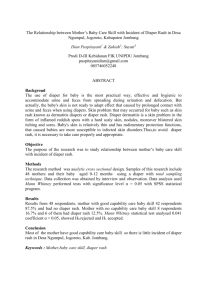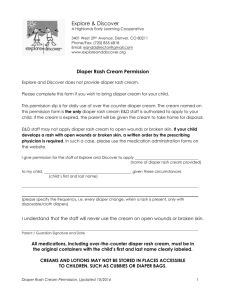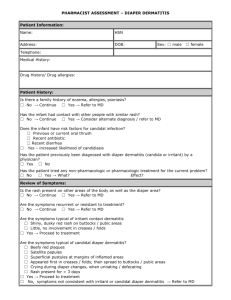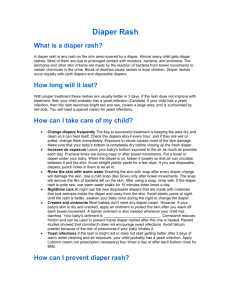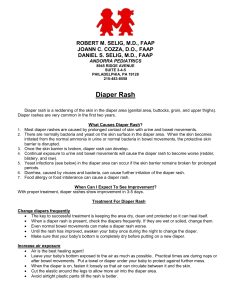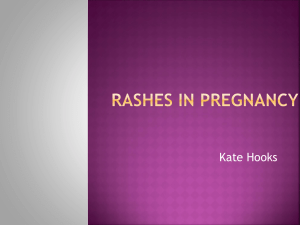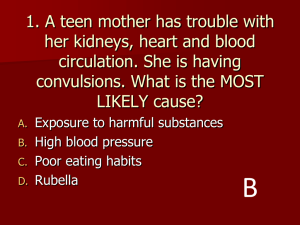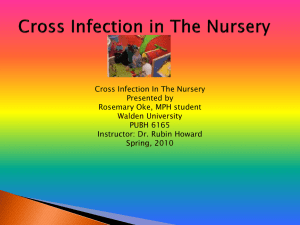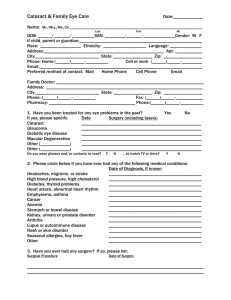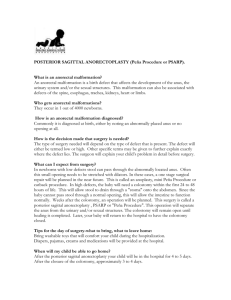Diaper Rash - Mat Su Midwifery
advertisement
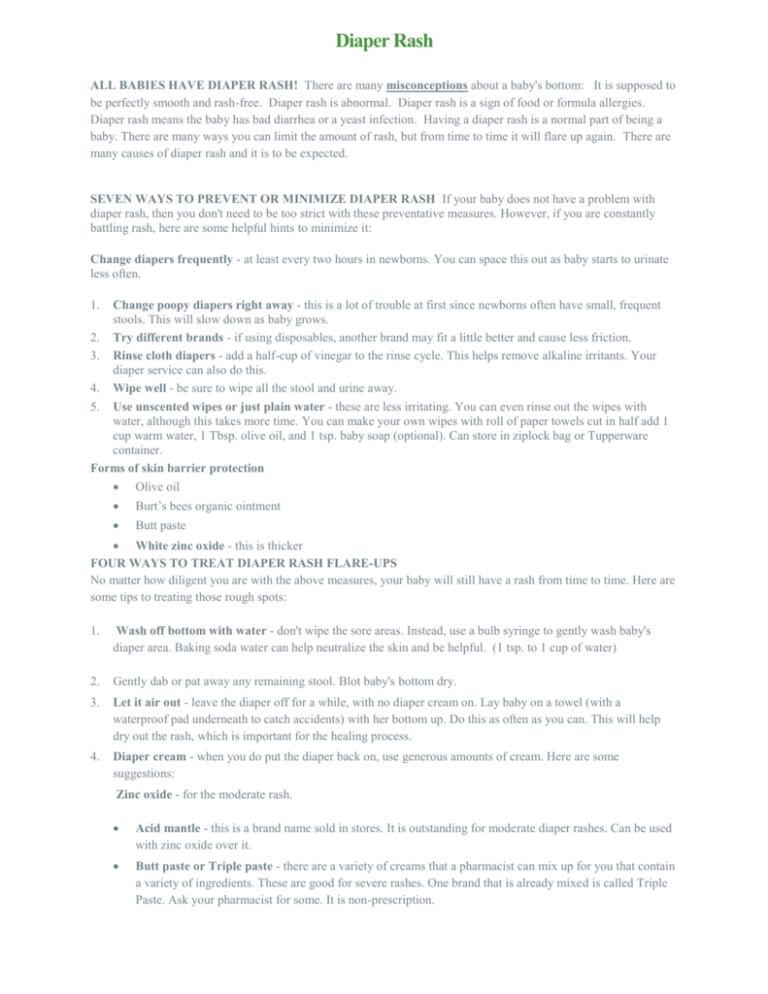
Diaper Rash ALL BABIES HAVE DIAPER RASH! There are many misconceptions about a baby's bottom: It is supposed to be perfectly smooth and rash-free. Diaper rash is abnormal. Diaper rash is a sign of food or formula allergies. Diaper rash means the baby has bad diarrhea or a yeast infection. Having a diaper rash is a normal part of being a baby. There are many ways you can limit the amount of rash, but from time to time it will flare up again. There are many causes of diaper rash and it is to be expected. SEVEN WAYS TO PREVENT OR MINIMIZE DIAPER RASH If your baby does not have a problem with diaper rash, then you don't need to be too strict with these preventative measures. However, if you are constantly battling rash, here are some helpful hints to minimize it: Change diapers frequently - at least every two hours in newborns. You can space this out as baby starts to urinate less often. 1. Change poopy diapers right away - this is a lot of trouble at first since newborns often have small, frequent stools. This will slow down as baby grows. 2. Try different brands - if using disposables, another brand may fit a little better and cause less friction. 3. Rinse cloth diapers - add a half-cup of vinegar to the rinse cycle. This helps remove alkaline irritants. Your diaper service can also do this. 4. Wipe well - be sure to wipe all the stool and urine away. 5. Use unscented wipes or just plain water - these are less irritating. You can even rinse out the wipes with water, although this takes more time. You can make your own wipes with roll of paper towels cut in half add 1 cup warm water, 1 Tbsp. olive oil, and 1 tsp. baby soap (optional). Can store in ziplock bag or Tupperware container. Forms of skin barrier protection Olive oil Burt’s bees organic ointment Butt paste White zinc oxide - this is thicker FOUR WAYS TO TREAT DIAPER RASH FLARE-UPS No matter how diligent you are with the above measures, your baby will still have a rash from time to time. Here are some tips to treating those rough spots: 1. Wash off bottom with water - don't wipe the sore areas. Instead, use a bulb syringe to gently wash baby's diaper area. Baking soda water can help neutralize the skin and be helpful. (1 tsp. to 1 cup of water) 2. Gently dab or pat away any remaining stool. Blot baby's bottom dry. 3. Let it air out - leave the diaper off for a while, with no diaper cream on. Lay baby on a towel (with a waterproof pad underneath to catch accidents) with her bottom up. Do this as often as you can. This will help dry out the rash, which is important for the healing process. 4. Diaper cream - when you do put the diaper back on, use generous amounts of cream. Here are some suggestions: Zinc oxide - for the moderate rash. Acid mantle - this is a brand name sold in stores. It is outstanding for moderate diaper rashes. Can be used with zinc oxide over it. Butt paste or Triple paste - there are a variety of creams that a pharmacist can mix up for you that contain a variety of ingredients. These are good for severe rashes. One brand that is already mixed is called Triple Paste. Ask your pharmacist for some. It is non-prescription. Clotrimazole anti-fungal cream - for stubborn rashes, yeast may be involved (see below). You can add this over-the-counter cream to help. Hydrocortisone 1% cream - you can put this over-the-counter cream on twice a day beneath any of the other creams to help with severe rashes. It will help with the inflammation. Don't use this for more than several days at a time as long-term use can damage the sensitive skin in the diaper area. Soothe and heal by Lansinoh. This pure lanolin ointment is excellent for soothing sore bottoms. Mix your own - if you can't get a prescription, try mixing these together in the palm of your hand, then apply to baby's bottom: Zinc oxide, White petroleum ointment, Acid mantle and Aluminum acetate (Burrow's solution) If you can’t find Acid Mantle, then use Lansinoh (a lanolin ointment). It is available in the diaper cream section of drug stores. IDENTIFYING SPECIFIC DIAPER RASHES Here are a few diaper rashes that can be more than just irritation from the stool, urine, and diaper. They usually require more specific therapy: If you try one of these and there is no improvement in 3-4 days they should come in because it is difficult to diagnose without being seen. There are some prescription alternatives available. 1. 2. 3. Contact diaper rash - this is simply the regular rash as discussed above. Appearance - flat, red, irritated skin. When severe, skin will peel or blister and slough off. Treatment - as described above. Intertrigo - this is a specific rash that occurs within the skin folds and creases around the diaper area where the skin rubs together. Appearance - Heat and moisture mixed with urine cause a red, burn-like appearance. Treatment - regular white petroleum diaper ointment. Yeast rash - when the skin is damaged, yeast from the intestines can invade the skin. This especially occurs with antibiotic use or prolonged rash. Appearance - it is a red, raised, patchy rash with sharp borders, mostly over the genitalia but with satellite spots sprinkled around the diaper area. Treatment - in addition to the above measures, there are two commonly used anti-fungal creams: 4. 5. 6. Clotrimazole - over-the-counter. Apply 2 - 3 times a days beneath the other creams. Acidophilus - this is a natural bacterial powder that fights off yeast. Impetigo - this occurs when bacteria invade the damaged skin. Appearance - coin-sized blisters or red raised patches that ooze a honey-colored crust. Treatment - above general measures. Seborrhea - an inflammatory condition that can affect different parts of the body, but can be especially severe in the diaper area. Appearance - a big, red, sharply demarcated patch over the groin, genitalia, and lower abdomen. It can be more raised, rough, thick, and greasy than the other rashes. Treatment - hydrocortisone 1% cream (over-the-counter) 2 - 3 times a day. Don't use more than a week unless directed by your doctor. Allergy ring - a variety of foods can irritate baby's bottom, especially acidic foods such as citrus and tomatobased sauces. Appearance - a red ring around baby's anus. Treatment - discontinue suspected foods. Breastfeeding moms may need to eliminate foods from their diet. WHEN TO WORRY None of the diaper rashes discussed here are so serious that they warrant an urgent call to your doctor in the evening or overnight. They generally can wait to be evaluated and treated by your doctor's office the following day.
